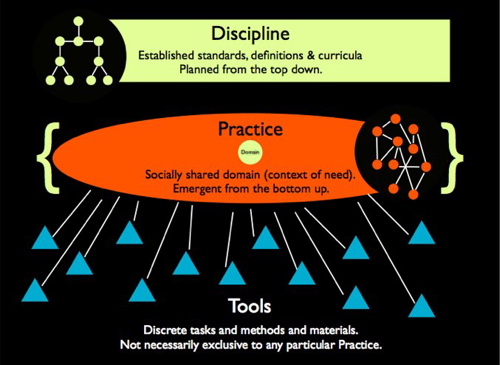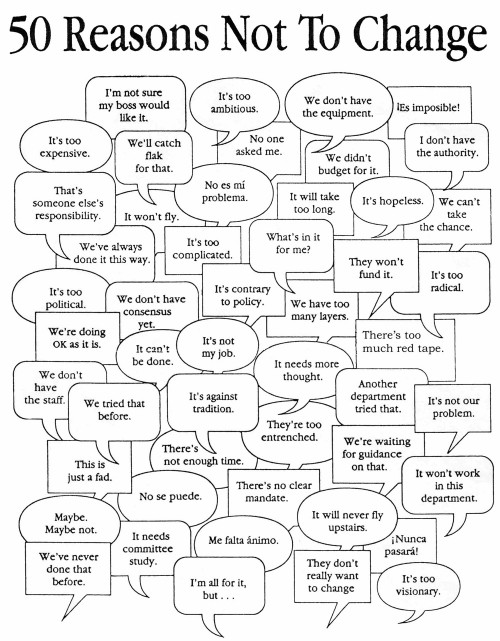Jan 10
Information Neighbourhood as a Social Software Ecosystem
I have written before about information neighbourhoods as arrangements of information and action opportunities that are contoured to the needs of a particular community or type of users. An example might be an information arrangement shaped to the needs of a particular project team, with the most frequently used resources most readily to hand, and additional links to their less frequently used resources. Check here and here for the background, and there’s a whole chapter in my book giving more detail on how information neighbourhoods fit into a knowledge organisation strategy for an enterprise.
Here’s a recent workshop video explaining the idea and the steps involved in designing an information neighbourhood. You can download the video file by right clickinghere. And here are the slides with some additional suggested templates for the activities.
Now, Thomas Vander Wal has stirred up my thinking with what I think will be widely recognised as a very important seminal post called “The Elements of the Social Software Stack”. Up till now I have been seeing the idea of the information neighbourhood as a shared information space, with a few links to actions tossed on the side. But of course, there’s no life in a neighbourhood if it has no sociability. It must, in Thomas’ terms accommodate identities as well as information objects. This was the idea I was grappling with in the city metaphor I used in a post I made over a year ago, “How to Kill a Knowledge Environment With the Taxonomy”.
I strongly recommend that you read Thomas’ account of the elements and the dependencies between them in full: and although he describes his idea of a “stack” in linear, progressive terms, the idea that kept coming through to me was that of an ecosystem, not just of interlinking parts, but leveraging the idea of “keystone species” – ie the species in an ecosystem upon which all other species depend, and without which the ecosystem will collapse. This would explain very well why technically you can have “all the right functionalities” in a knowledge sharing system, but somehow it just doesn’t work. But whether the metaphor is organic or mechanical, this is a really important article for knowledge managers to read, to help them figure out whether their platforms for knowledge sharing are (a) complete and (b) workable.

Jan 09
Communities, Professions and KM
Andrew Hinton has a very good slideshow on “User Experience (UX) Design as Communities of Practice” with some great slide commentary. It’s not just a very elegant analysis of the role of self-determined communities contrasted with organised hierarchies (and it is) – it also probes some questions about the “metadiscipline” of UX which have some strong parallels with knowledge and information management.
Both UX and KM/IM depend on a rich and varied clutchbag of diverse skill sets, technical knowledge domains, and professional approaches. And figuring out the relationships between professions (which Andrew sees as organised hierarchies) and disciplines/metadisciplines and communities may go some way to answering some of the questions that were troubling me in my rant about extinction back in August. Thanks to Chris Baum at Boxes and Arrows for this tip.

Jan 09
Ethics and Social Network Analysis
Via Graham Durant-Law this extremely valuable paper from Stephen Borgatti and Jose-Luis Molina – not just looking at the ethical issues in social network analysis but giving very clear practical guidance on how to navigate them, suggesting a management disclosure contract for “the researcher and the organization to agree in writing on exactly what data management will be allowed to see, and what kinds of decisions management will be allowed to make based on these data. This management disclosure contract (MDC) should be signed by management and by the researcher, and a copy of the signed form can then be included with the consent form signed by the respondent.”
The paper also provides a sample contract. Really nice to see this grounded serious response to a real issue rather than the flippant pot shots against a valuable tool (or the breathless adoration for it) that we more often see.
Jan 08
Resources on Taxonomies and Tagging
For those of you who you don’t regularly follow my book blog, there have been a number of recent posts on taxonomies and tagging, including lessons from burglars and emperors. Hurry on over!
Jan 08
Taking the Pass out of Spill Checkers
Very naughty take on spell checkers, taxonomists among you might think of auto-categorization engines as well. And in the spirit of this video, I’d like to propose an Advanced Turing Test: a machine has achieved the equivalent of truly human intelligence if it can not only detect its own mistakes but also laugh at them. Thanks to Annette Clancy for this.
Jan 08
Plus Ca Resistance a Change
From M. Pam Bumsted this delightful graphic (which must have its uses in a workshop) of 50 Reasons Not to Change. Via Annette Clancy. Click the thumb below to see the full scale original at Pam’s blog.
Jan 07
Searching KM Journals
Google Scholar is a wonderful tool, but sometimes you want to find out quickly what the mainstream KM journals have on a particular topic. So I’ve created this Google Custom Search Engine for KM journal and magazine articles, currently searching the sites of 20 publishers and content providers. Don’t use it instead of Scholar, but alongside. Try it out! (And check out David Gurteen’s broader customised KM search engine covering almost 900 sites).
Jan 07
Beliefs
Another of the joys of serendipity today, thanks to Greg Lloyd. I’ve come across JP Rangaswami’s Confused of Calcutta blog a few times before, but had never looked at his section marked “About this Blog”. It’s a series of statements about his beliefs, the first two of which strike to the heart of what occupies our company Straits Knowledge:
“I believe that it is only a matter of time before enterprise software consists of only four types of application: publishing, search, fulfilment and conversation. I believe that weaknesses and corruptions in our own thinking about digital rights and intellectual property rights will have the effect of slowing down or sometimes even blocking this from happening.
I believe we keep building layers of lock-in that prevent information from flowing freely, and that we have a lot to learn about the right thing to do in this respect. I believe identity and presence and authentication and permissioning are in some ways the new battlegrounds, where the freedom of information flow will be fought for, and bitterly at that.”
So I’ve subscribed.

Jan 07
Barbaric Communities
This sober post from Miguel Cornejo Castro about a very nasty attack on his online community (involving child pornography among other things) reveals (a) how the online environment has yet to be civilised and (b) how a firm hand, good intelligence and absolute determination are needed if your community gains any sort of public prominence on the internet. Miguel has clashed a couple of times with Dave Snowden on emergent approaches to communities, and interventionist type approaches. In this case, although it was not an internal community issue, I appreciate Miguel’s toughness.
Jan 04
Doing KM One Person at a Time
Yesterday, for the first time in my KM consulting career I did something that I had not had the chance to do before. My colleague Paolina and I held a “clinic” at our client’s office; people were invited to come talk to us to figure out how they could apply knowledge sharing tools and techniques in their project or work area (this organisation has put some people through a programme which equips them with a suite of knowledge sharing techniques). This is not the usual high-level stuff that we do with clients, eg, KM strategy and roadmap development, but for some reason it felt very satisfying.


